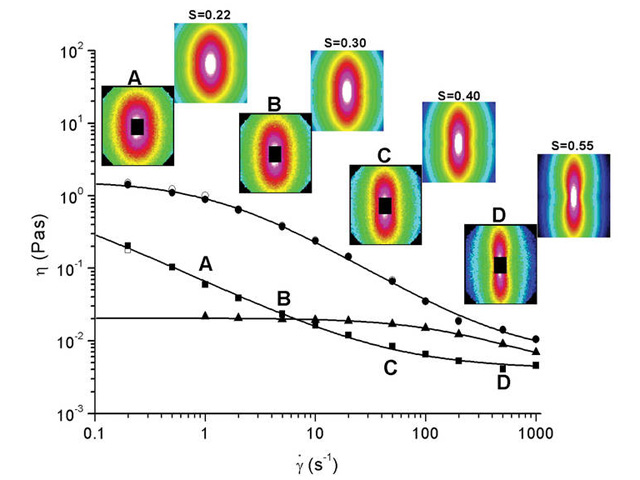D11
Lowest momentum transfer & lowest background small-angle neutron scattering instrument
Shearing of Wormlike Micelles
Shear thinning and orientation of cylindrical surfactant and block copolymer micelles was investigated at D11 over a broad range of shear rates and concentrations with rheo-SANS, a powerful technique that can be used to obtain a detailed molecular picture of the structural changes of complex fluids under shear, For these experiments our recently developed Searle-type shear cell was used on a commercial Bohlin CV-120 HR rheometer.
In sheared solution, elongated objects such as wormlike micelles align in the flow direction, with an orientational distribution that can be well described by an Onsager-type distribution function. The shear viscosity measured as a function of shear rate for 3 different micellar solutions is shown in the figure and shows pronounced shear thinning. Also shown in the figure are 4 examples of in situ measured anisotropic small angle neutron scattering patterns, together with the corresponding calculation. From the calculated scattering patterns the orientational order parameter S can be determined. It lies in a range 0.05 = S = 0.85 for the different wormlike micellar solutions at different concentrations and shear rates studied here.
The relation between shear viscosity and order parameter reveals important features of the molecular orientation process.
In summary, this study shows that shear thinning and orientation of wormlike micelles is observed for ![]() t dis >> 1, where t dis is the disentanglement time of the micelles and
t dis >> 1, where t dis is the disentanglement time of the micelles and ![]() is the shear rate. In this regime there is a simple functional relationship of the type h z e-as between the shear viscosity and the order parameter S, with a common slope a for all samples over a wide range of concentrations and shear rates. The study provides direct relations between bulk properties like shear rate and shear viscosity, and molecular properties such as micellar thickness and orientation distribution of long wormlike micelles or fibrous structures.
is the shear rate. In this regime there is a simple functional relationship of the type h z e-as between the shear viscosity and the order parameter S, with a common slope a for all samples over a wide range of concentrations and shear rates. The study provides direct relations between bulk properties like shear rate and shear viscosity, and molecular properties such as micellar thickness and orientation distribution of long wormlike micelles or fibrous structures.
Ref.: Berret J.F. , Roux D.C., Journal of Rheology 39, 725-741 (1995)

